turn signal Lancia Delta 2010 Owner handbook (in English)
[x] Cancel search | Manufacturer: LANCIA, Model Year: 2010, Model line: Delta, Model: Lancia Delta 2010Pages: 276, PDF Size: 5.31 MB
Page 12 of 276
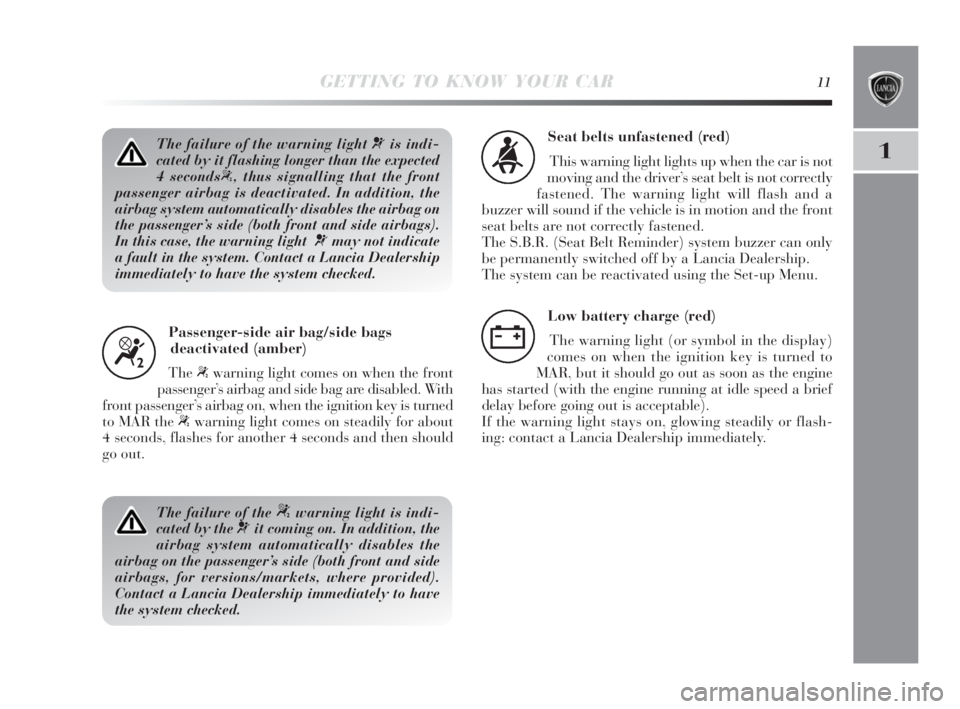
GETTING TO KNOW YOUR CAR11
1The failure of the warning light ¬is indi-
cated by it flashing longer than the expected
4 seconds
“, thus signalling that the front
passenger airbag is deactivated. In addition, the
airbag system automatically disables the airbag on
the passenger’s side (both front and side airbags).
In this case, the warning light
¬may not indicate
a fault in the system. Contact a Lancia Dealership
immediately to have the system checked.
Passenger-side air bag/side bags
deactivated (amber)
The
“warning light comes on when the front
passenger’s airbag and side bag are disabled. With
front passenger’s airbag on, when the ignition key is turned
to MAR the
“warning light comes on steadily for about
4 seconds, flashes for another 4 seconds and then should
go out.
“
The failure of the “warning light is indi-
cated by the
¬it coming on. In addition, the
airbag system automatically disables the
airbag on the passenger’s side (both front and side
airbags, for versions/markets, where provided).
Contact a Lancia Dealership immediately to have
the system checked.
Seat belts unfastened (red)
This warning light lights up when the car is not
moving and the driver’s seat belt is not correctly
fastened. The warning light will flash and a
buzzer will sound if the vehicle is in motion and the front
seat belts are not correctly fastened.
The S.B.R. (Seat Belt Reminder) system buzzer can only
be permanently switched off by a Lancia Dealership.
The system can be reactivated using the Set-up Menu.
<
Low battery charge (red)
The warning light (or symbol in the display)
comes on when the ignition key is turned to
MAR, but it should go out as soon as the engine
has started (with the engine running at idle speed a brief
delay before going out is acceptable).
If the warning light stays on, glowing steadily or flash-
ing: contact a Lancia Dealership immediately.
w
001-142 Delta 3ed gb 30-11-2009 11:21 Pagina 11
Page 13 of 276
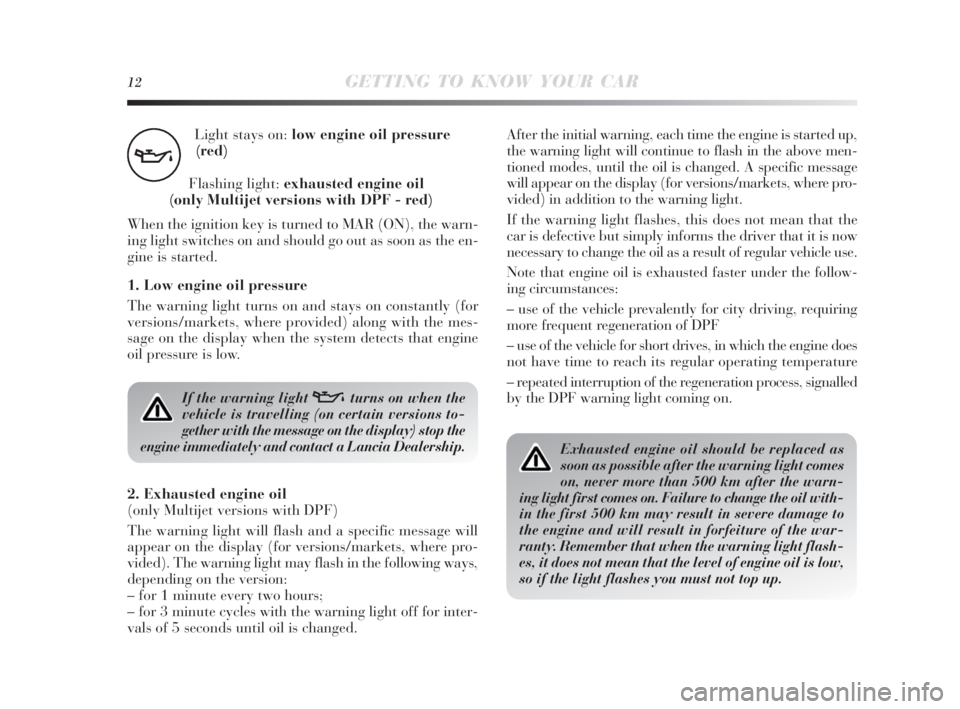
12GETTING TO KNOW YOUR CAR
Light stays on: low engine oil pressure
(red)
Flashing light: exhausted engine oil
(only Multijet versions with DPF - red)
When the ignition key is turned to MAR (ON), the warn-
ing light switches on and should go out as soon as the en-
gine is started.
1. Low engine oil pressure
The warning light turns on and stays on constantly (for
versions/markets, where provided) along with the mes-
sage on the display when the system detects that engine
oil pressure is low.
v
Exhausted engine oil should be replaced as
soon as possible after the warning light comes
on, never more than 500 km after the warn-
ing light first comes on. Failure to change the oil with-
in the first 500 km may result in severe damage to
the engine and will result in forfeiture of the war-
ranty. Remember that when the warning light flash-
es, it does not mean that the level of engine oil is low,
so if the light flashes you must not top up.
If the warning light vturns on when the
vehicle is travelling (on certain versions to-
gether with the message on the display) stop the
engine immediately and contact a Lancia Dealership.
2. Exhausted engine oil
(only Multijet versions with DPF)
The warning light will flash and a specific message will
appear on the display (for versions/markets, where pro-
vided). The warning light may flash in the following ways,
depending on the version:
– for 1 minute every two hours;
– for 3 minute cycles with the warning light off for inter-
vals of 5 seconds until oil is changed.After the initial warning, each time the engine is started up,
the warning light will continue to flash in the above men-
tioned modes, until the oil is changed. A specific message
will appear on the display (for versions/markets, where pro-
vided) in addition to the warning light.
If the warning light flashes, this does not mean that the
car is defective but simply informs the driver that it is now
necessary to change the oil as a result of regular vehicle use.
Note that engine oil is exhausted faster under the follow-
ing circumstances:
– use of the vehicle prevalently for city driving, requiring
more frequent regeneration of DPF
– use of the vehicle for short drives, in which the engine does
not have time to reach its regular operating temperature
– repeated interruption of the regeneration process, signalled
by the DPF warning light coming on.
001-142 Delta 3ed gb 30-11-2009 11:21 Pagina 12
Page 19 of 276
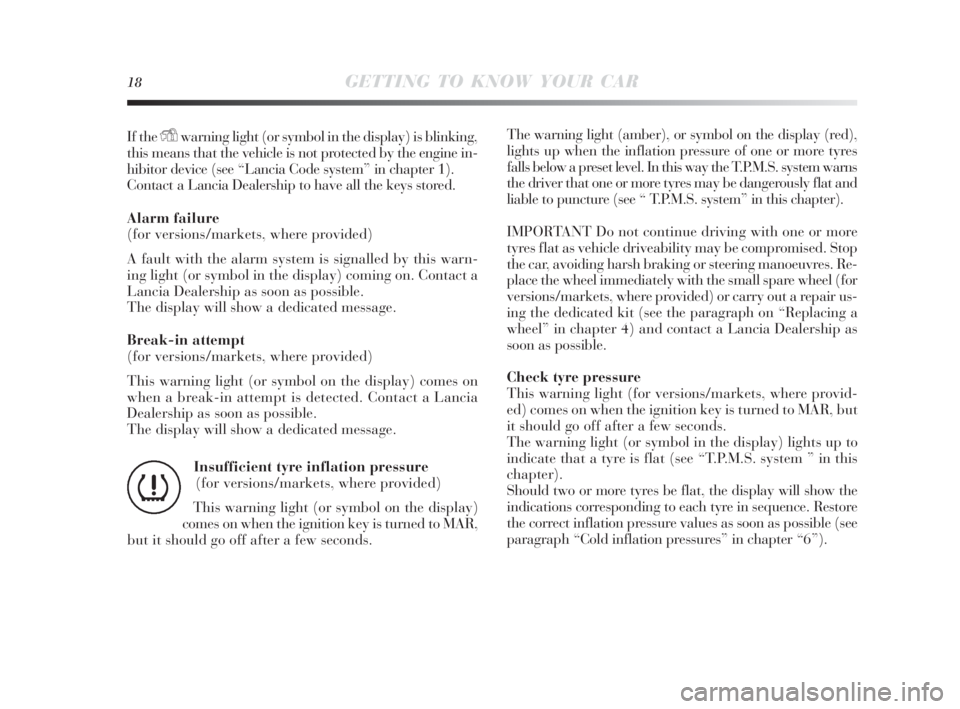
18GETTING TO KNOW YOUR CAR
If the Ywarning light (or symbol in the display) is blinking,
this means that the vehicle is not protected by the engine in-
hibitor device (see “Lancia Code system” in chapter 1).
Contact a Lancia Dealership to have all the keys stored.
Alarm failure
(for versions/markets, where provided)
A fault with the alarm system is signalled by this warn-
ing light (or symbol in the display) coming on. Contact a
Lancia Dealership as soon as possible.
The display will show a dedicated message.
Break-in attempt
(for versions/markets, where provided)
This warning light (or symbol on the display) comes on
when a break-in attempt is detected. Contact a Lancia
Dealership as soon as possible.
The display will show a dedicated message.The warning light (amber), or symbol on the display (red),
lights up when the inflation pressure of one or more tyres
falls below a preset level. In this way the T.P.M.S. system warns
the driver that one or more tyres may be dangerously flat and
liable to puncture (see “ T.P.M.S. system” in this chapter).
IMPORTANT Do not continue driving with one or more
tyres flat as vehicle driveability may be compromised. Stop
the car, avoiding harsh braking or steering manoeuvres. Re-
place the wheel immediately with the small spare wheel (for
versions/markets, where provided) or carry out a repair us-
ing the dedicated kit (see the paragraph on “Replacing a
wheel” in chapter 4) and contact a Lancia Dealership as
soon as possible.
Check tyre pressure
This warning light (for versions/markets, where provid-
ed) comes on when the ignition key is turned to MAR, but
it should go off after a few seconds.
The warning light (or symbol in the display) lights up to
indicate that a tyre is flat (see “T.P.M.S. system ” in this
chapter).
Should two or more tyres be flat, the display will show the
indications corresponding to each tyre in sequence. Restore
the correct inflation pressure values as soon as possible (see
paragraph “Cold inflation pressures” in chapter “6”). Insufficient tyre inflation pressure
(for versions/markets, where provided)
This warning light (or symbol on the display)
comes on when the ignition key is turned to MAR,
but it should go off after a few seconds.
n
001-142 Delta 3ed gb 30-11-2009 11:21 Pagina 18
Page 38 of 276
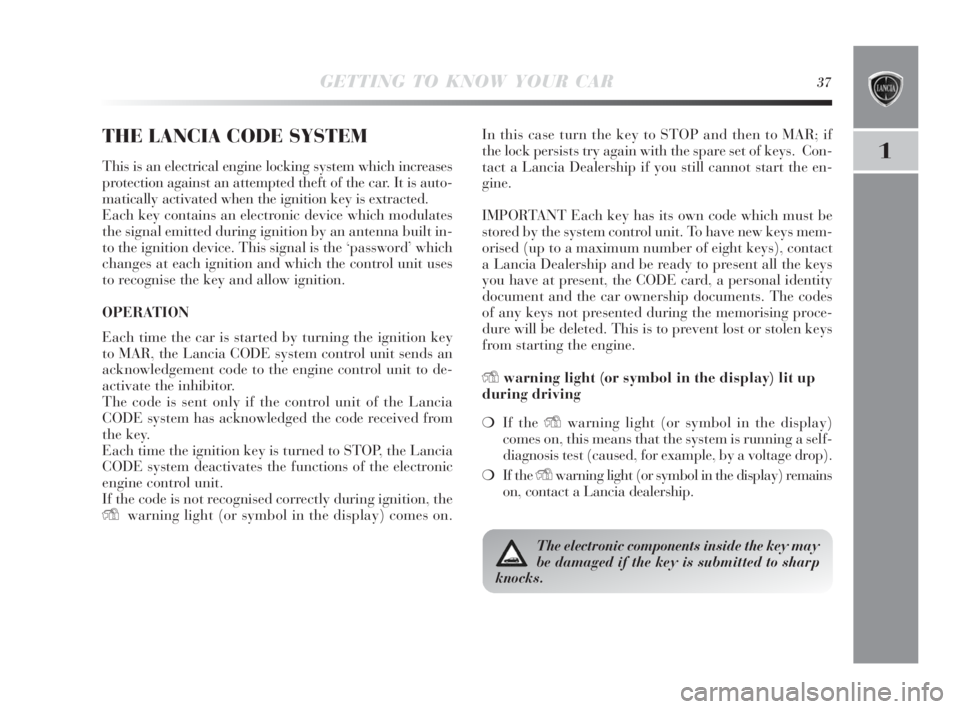
GETTING TO KNOW YOUR CAR37
1
THE LANCIA CODE SYSTEM
This is an electrical engine locking system which increases
protection against an attempted theft of the car. It is auto-
matically activated when the ignition key is extracted.
Each key contains an electronic device which modulates
the signal emitted during ignition by an antenna built in-
to the ignition device. This signal is the ‘password’ which
changes at each ignition and which the control unit uses
to recognise the key and allow ignition.
OPERATION
Each time the car is started by turning the ignition key
to MAR, the Lancia CODE system control unit sends an
acknowledgement code to the engine control unit to de-
activate the inhibitor.
The code is sent only if the control unit of the Lancia
CODE system has acknowledged the code received from
the key.
Each time the ignition key is turned to STOP, the Lancia
CODE system deactivates the functions of the electronic
engine control unit.
If the code is not recognised correctly during ignition, the
Ywarning light (or symbol in the display) comes on.In this case turn the key to STOP and then to MAR; if
the lock persists try again with the spare set of keys. Con-
tact a Lancia Dealership if you still cannot start the en-
gine.
IMPORTANT Each key has its own code which must be
stored by the system control unit. To have new keys mem-
orised (up to a maximum number of eight keys), contact
a Lancia Dealership and be ready to present all the keys
you have at present, the CODE card, a personal identity
document and the car ownership documents. The codes
of any keys not presented during the memorising proce-
dure will be deleted. This is to prevent lost or stolen keys
from starting the engine.
Ywarning light (or symbol in the display) lit up
during driving
❍If the Ywarning light (or symbol in the display)
comes on, this means that the system is running a self-
diagnosis test (caused, for example, by a voltage drop).
❍If the Ywarning light (or symbol in the display) remains
on, contact a Lancia dealership.
The electronic components inside the key may
be damaged if the key is submitted to sharp
knocks.
001-142 Delta 3ed gb 30-11-2009 11:21 Pagina 37
Page 43 of 276
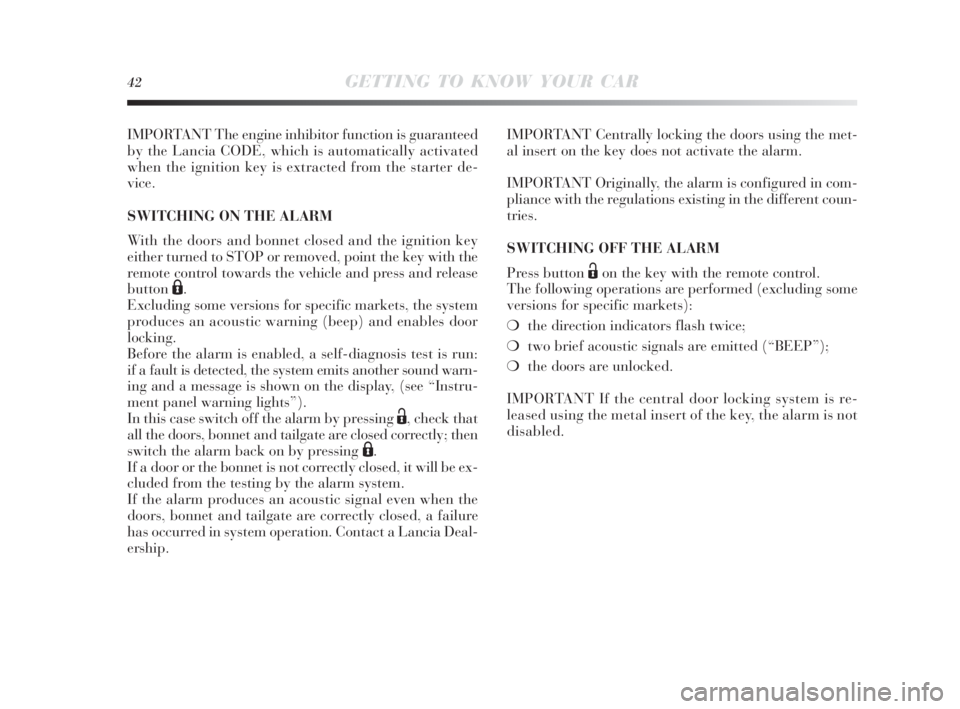
42GETTING TO KNOW YOUR CAR
IMPORTANT The engine inhibitor function is guaranteed
by the Lancia CODE, which is automatically activated
when the ignition key is extracted from the starter de-
vice.
SWITCHING ON THE ALARM
With the doors and bonnet closed and the ignition key
either turned to STOP or removed, point the key with the
remote control towards the vehicle and press and release
button
Á.
Excluding some versions for specific markets, the system
produces an acoustic warning (beep) and enables door
locking.
Before the alarm is enabled, a self-diagnosis test is run:
if a fault is detected, the system emits another sound warn-
ing and a message is shown on the display, (see “Instru-
ment panel warning lights”).
In this case switch off the alarm by pressing
Ë, check that
all the doors, bonnet and tailgate are closed correctly; then
switch the alarm back on by pressing
Á.
If a door or the bonnet is not correctly closed, it will be ex-
cluded from the testing by the alarm system.
If the alarm produces an acoustic signal even when the
doors, bonnet and tailgate are correctly closed, a failure
has occurred in system operation. Contact a Lancia Deal-
ership.IMPORTANT Centrally locking the doors using the met-
al insert on the key does not activate the alarm.
IMPORTANT Originally, the alarm is configured in com-
pliance with the regulations existing in the different coun-
tries.
SWITCHING OFF THE ALARM
Press button
Ëon the key with the remote control.
The following operations are performed (excluding some
versions for specific markets):
❍the direction indicators flash twice;
❍two brief acoustic signals are emitted (“BEEP”);
❍the doors are unlocked.
IMPORTANT If the central door locking system is re-
leased using the metal insert of the key, the alarm is not
disabled.
001-142 Delta 3ed gb 30-11-2009 11:21 Pagina 42
Page 64 of 276
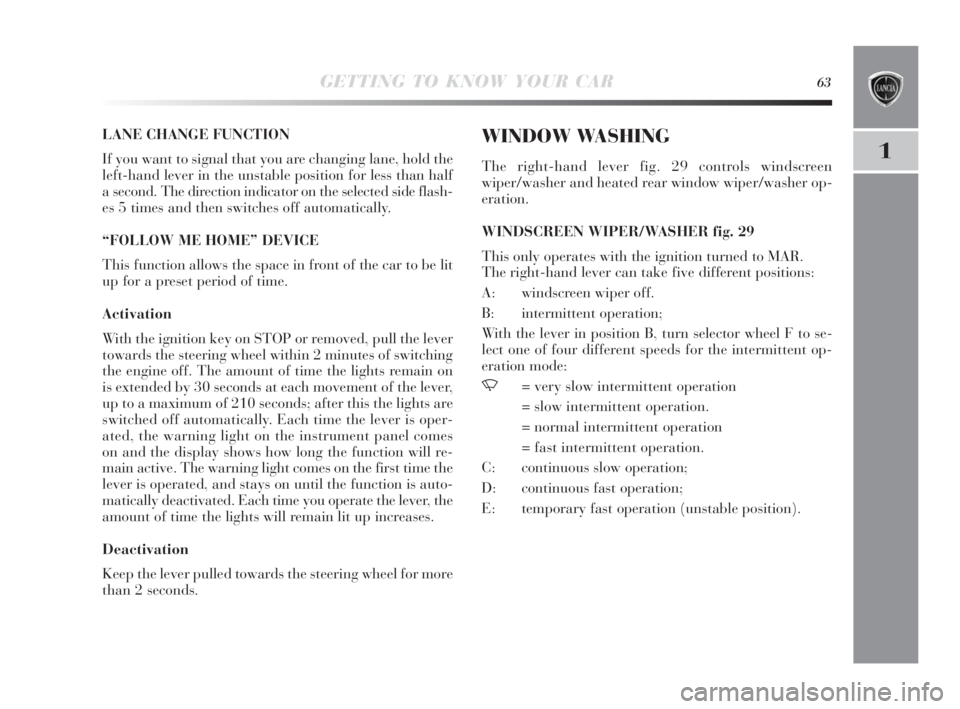
GETTING TO KNOW YOUR CAR63
1
LANE CHANGE FUNCTION
If you want to signal that you are changing lane, hold the
left-hand lever in the unstable position for less than half
a second. The direction indicator on the selected side flash-
es 5 times and then switches off automatically.
“FOLLOW ME HOME” DEVICE
This function allows the space in front of the car to be lit
up for a preset period of time.
Activation
With the ignition key on STOP or removed, pull the lever
towards the steering wheel within 2 minutes of switching
the engine off. The amount of time the lights remain on
is extended by 30 seconds at each movement of the lever,
up to a maximum of 210 seconds; after this the lights are
switched off automatically. Each time the lever is oper-
ated, the warning light on the instrument panel comes
on and the display shows how long the function will re-
main active. The warning light comes on the first time the
lever is operated, and stays on until the function is auto-
matically deactivated. Each time you operate the lever, the
amount of time the lights will remain lit up increases.
Deactivation
Keep the lever pulled towards the steering wheel for more
than 2 seconds.WINDOW WASHING
The right-hand lever fig. 29 controls windscreen
wiper/washer and heated rear window wiper/washer op-
eration.
WINDSCREEN WIPER/WASHER fig. 29
This only operates with the ignition turned to MAR.
The right-hand lever can take five different positions:
A: windscreen wiper off.
B: intermittent operation;
With the lever in position B, turn selector wheel F to se-
lect one of four different speeds for the intermittent op-
eration mode:
,= very slow intermittent operation
= slow intermittent operation.
= normal intermittent operation
= fast intermittent operation.
C: continuous slow operation;
D: continuous fast operation;
E: temporary fast operation (unstable position).
001-142 Delta 3ed gb 30-11-2009 11:22 Pagina 63
Page 66 of 276

GETTING TO KNOW YOUR CAR65
1
fig. 30L0E0023m
The rear window wiper stops operating a few strokes af-
ter the lever is released; after a few seconds, a further
cleaning stroke completes the wiping operation.
RAIN SENSOR
(for versions/markets, where provided)
The rain sensor A-fig. 30 is located behind the interior
rear-view mirror in contact with the windscreen and au-
tomatically adjusts the frequency of the windscreen wiper
strokes according to the rain intensity during intermittent
operation.
The sensor has an adjustment range that varies progres-
sively from wiper still (no stroke) when the windscreen
is dry, to wiper at first continuous speed (slow continu-
ous operation) with intense rain.Activation
Move the right lever down by one click.
The activation of the rain sensor is signalled by a com-
mand acquisition stroke.
IMPORTANT Keep the glass in the sensor area clean.
By turning selector wheel F-fig. 29 is it possible to increase
the sensitivity of the rain sensor to obtain a more rapid
variation between wiper still (no stroke) when the wind-
screen is dry, to wiper at first continuous speed (slow con-
tinuous operation).
The increase in the sensitivity of the rain sensor is signalled
by a control and acquisition “stroke”.
When the windscreen washer is operated with the rain sen-
sor activated, the normal washing cycle is performed, at
the end of which the rain sensor resumes its normal au-
tomatic function.
001-142 Delta 3ed gb 30-11-2009 11:22 Pagina 65
Page 68 of 276
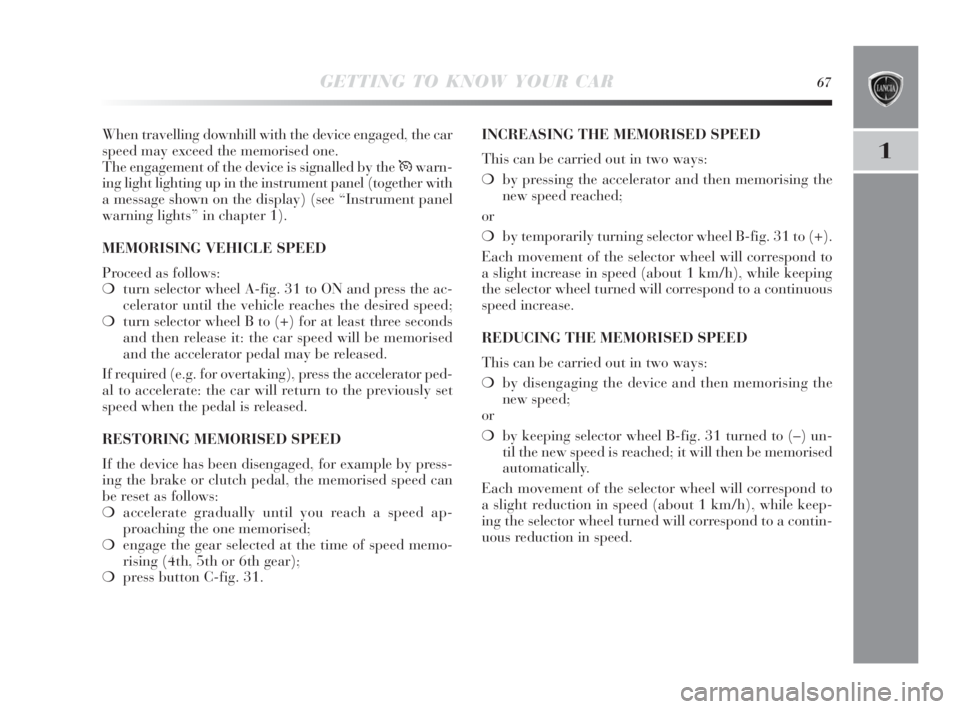
GETTING TO KNOW YOUR CAR67
1
When travelling downhill with the device engaged, the car
speed may exceed the memorised one.
The engagement of the device is signalled by the Üwarn-
ing light lighting up in the instrument panel (together with
a message shown on the display) (see “Instrument panel
warning lights” in chapter 1).
MEMORISING VEHICLE SPEED
Proceed as follows:
❍turn selector wheel A-fig. 31 to ON and press the ac-
celerator until the vehicle reaches the desired speed;
❍turn selector wheel B to (+) for at least three seconds
and then release it: the car speed will be memorised
and the accelerator pedal may be released.
If required (e.g. for overtaking), press the accelerator ped-
al to accelerate: the car will return to the previously set
speed when the pedal is released.
RESTORING MEMORISED SPEED
If the device has been disengaged, for example by press-
ing the brake or clutch pedal, the memorised speed can
be reset as follows:
❍accelerate gradually until you reach a speed ap-
proaching the one memorised;
❍engage the gear selected at the time of speed memo-
rising (4th, 5th or 6th gear);
❍press button C-fig. 31.INCREASING THE MEMORISED SPEED
This can be carried out in two ways:
❍by pressing the accelerator and then memorising the
new speed reached;
or
❍by temporarily turning selector wheel B-fig. 31 to (+).
Each movement of the selector wheel will correspond to
a slight increase in speed (about 1 km/h), while keeping
the selector wheel turned will correspond to a continuous
speed increase.
REDUCING THE MEMORISED SPEED
This can be carried out in two ways:
❍by disengaging the device and then memorising the
new speed;
or
❍by keeping selector wheel B-fig. 31 turned to (–) un-
til the new speed is reached; it will then be memorised
automatically.
Each movement of the selector wheel will correspond to
a slight reduction in speed (about 1 km/h), while keep-
ing the selector wheel turned will correspond to a contin-
uous reduction in speed.
001-142 Delta 3ed gb 30-11-2009 11:22 Pagina 67
Page 107 of 276

106GETTING TO KNOW YOUR CAR
OPERATION
The system is not activated when the vehicle is started.
It is only activated when button A-fig. 71 on the dash-
board is pressed. Activation is confirmed by the lighting
up of the LED on the button and a dedicated message ap-
pearing on the display. Once it is turned on the system will
recognize the operating conditions which is signalled to
the driver by the LED located in the button flashing and
the symbol
ein the amber coloured panel in the instru-
ment panel display flashing too. Once the system has
recognised the operating conditions, it becomes active.
When this happens: the
eicon on the display goes out
and the LED on the button remains on constantly.
IMPORTANT If the operating conditions are no longer
present then the system will deactivate. This is signalled
to the driver by: the LED on the button and the amber
eicon on the display flashing.
OPERATING CONDITIONS FOR ACTIVATION
Once switched on, the system becomes active only if the
following conditions are present:
❍always keep at least one hand on the steering wheel;
❍vehicle speed between 65 km/h and 180 km/h;
❍presence of lane demarcation lines not deteriorated and
visible on both sides;
❍suitable visibility conditions;
❍straight road or wide curves;
❍visual field condition sufficient (safety distance from
vehicle in front). ACTIVATING/DEACTIVATING THE SYSTEM
When the system is active, if the vehicle nears one of the
side lane markings a torque is applied to the steering wheel
advising the driver of the direction the steering wheel needs
to the turned to stay in the present lane.
If the driver turns on the direction indicator in order to
change lanes or for overtaking, then the system will switch
off momentarily. If the driver wishes to change lanes with-
out turning the direction indicator on, then there will be
a warning from the steering wheel that they are about to
cross the line. If the driver continues with the manoeuvre
to change lanes, the system will be temporarily deactivated
and then switch back on again once it has recognized the
new driving lane. This temporary deactivation will be sig-
nalled to the driver by the LED in the button flashing and
by the symbol
ein the amber coloured panel in the in-
strument panel display also flashing.
001-142 Delta 3ed gb 30-11-2009 11:22 Pagina 106
Page 108 of 276

GETTING TO KNOW YOUR CAR107
1
SWITCHING OFF THE SYSTEM
Manual method
The system can be deactivated by pressing button A-fig. 71
on the dashboard.
Confirmation of system deactivation is signalled by the
LED on the button going out and a message 1-fig. 72 ap-
pearing on the display.
Automatic method
The system can be deactivated automatically (if the sys-
tem is required it will therefore need to be reactivated).
The driver is advised that the system has been turned off au-
tomatically by three consecutive acoustic signals and the mes-
sage 1 – fig. 72 in the instrument panel display after the fol-
lowing situations:
❍the driver does not keep his hands on the steering wheel
(indication 2-fig. 72 is shown on the instrument pan-
el and a buzzer sounds until the driver places his hands
back on the wheel. This is considered a dangerous con-
dition and the system is automatically deactivated);
❍triggering of the vehicle safety systems (ABS, ESP,
ASR, DST and TTC);
❍the driver sets the sports driving pressing the SPORT
button (for versions/markets, where provided).
WARNING: the system cannot be activated if the driver
has previously selected the sport driving mode. The im-
possibility of using the system will be communicated to
the driver by three consecutive beeps and by the displayed
message 1 in fig. 72.SYSTEM FAILURE
In the event of a malfunction, the system reports the fault
via a message 3-fig. 72 appearing on the display and a
buzzer sounding.
IMPORTANT
The driving advisor is unable to operate following a malfunc-
tion in any of the following safety systems: ABS, ESP, ASR,
DST and TTC.
In the presence of indistinct, overlapping or
missing lane markings, the lane assistance
function is unable to aid the driver and the
system will be deactivated.
The driving advisor is not an automatic dri-
ving system and cannot replace the driver in
controlling the vehicle trajectory. The driver
is personally responsible for maintaining a suitable
level of concentration as traffic and road conditions
require, and for safely controlling the vehicle’s tra-
jectory.
The operation of the lane assistance function may be com-
promised by adverse visibility conditions (rain, fog, snow),
extreme lighting conditions (solar glare, darkness) or dirt
or damage, even partial, to the windscreen in the area
around the video camera.
The area of the windscreen by the TV camera should not
be partly or totally obscured by objects (e.g. stickers, pro-
tective film, etc.)
001-142 Delta 3ed gb 30-11-2009 13:22 Pagina 107